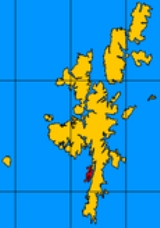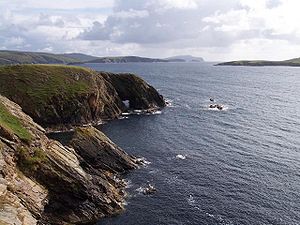
East Burra
Encyclopedia

Scalloway Islands
The Scalloway Islands are in Shetland opposite Scalloway on south west of the Mainland . They form a mini-archipelago and include:* Burra ** West Burra...
, a subgroup of the Shetland Islands
Shetland Islands
Shetland is a subarctic archipelago of Scotland that lies north and east of mainland Great Britain. The islands lie some to the northeast of Orkney and southeast of the Faroe Islands and form part of the division between the Atlantic Ocean to the west and the North Sea to the east. The total...
in Scotland
Scotland
Scotland is a country that is part of the United Kingdom. Occupying the northern third of the island of Great Britain, it shares a border with England to the south and is bounded by the North Sea to the east, the Atlantic Ocean to the north and west, and the North Channel and Irish Sea to the...
. It is connected by a bridge to West Burra.
With an area of two square miles, it is the eleventh largest of the Shetland Islands.
East Burra has a much smaller population than West Burra and no substantial settlement; rather, there are a few hamlets and a scattering of individual croft houses. It is known for its Neolithic
Neolithic
The Neolithic Age, Era, or Period, or New Stone Age, was a period in the development of human technology, beginning about 9500 BC in some parts of the Middle East, and later in other parts of the world. It is traditionally considered as the last part of the Stone Age...
remains including a burnt mound
Burnt mound
A burnt mound is an archaeological feature consisting of a mound of shattered stones and charcoal, normally with an adjacent hearth and trough. The trough could be rock-cut, wood-lined or clay-lined to ensure it was watertight...
, and for sea caves. The roofless, plain, Old Haa (manor or laird's house) of Houss is a prominent feature. From Houss, it is possible to walk the two kilometres or so to the cliffs at the southern end of the island. From there, the island of South Havra
South Havra
South Havra is an uninhabited island in the Scalloway Islands, Shetland, Scotland.-Geography and geology:South Havra lies south of Burra and west of the southern peninsula of the Mainland, Shetland....
, nowadays home only to sheep and seabirds, can be clearly seen.
East Burra is linked to the Shetland Mainland
Shetland Mainland
The Mainland is the main island of Shetland, Scotland. The island contains Shetland's only burgh, Lerwick, and is the centre of Shetland's ferry and air connections....
via West Burra and Trondra
Trondra
Trondra is one of the Scalloway Islands, a subgroup of the Shetland Islands in Scotland. It shelters the harbour of Scalloway and has an area of .-History:...
by a series of bridge
Bridge
A bridge is a structure built to span physical obstacles such as a body of water, valley, or road, for the purpose of providing passage over the obstacle...
s.

